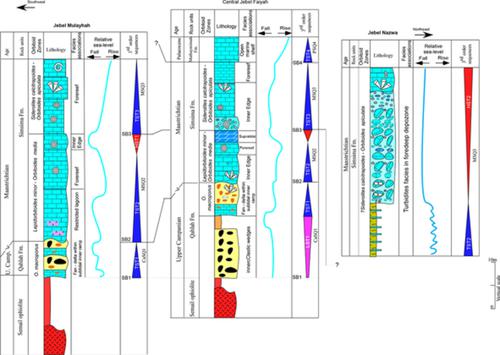当前位置:
X-MOL 学术
›
Geolog. J.
›
论文详情
Our official English website, www.x-mol.net, welcomes your
feedback! (Note: you will need to create a separate account there.)
Upper Cretaceous wedge‐top to foredeep architecture in the United Arab Emirates: Insights from the Faiyah Anticline
Geological Journal ( IF 1.4 ) Pub Date : 2020-12-27 , DOI: 10.1002/gj.4057 Ibrahim Q. Mohammed 1 , Sherif Farouk 2 , Fadhil Lawa 3 , Mohammad Alsuwaidi 4 , Sadoon Morad 4
Geological Journal ( IF 1.4 ) Pub Date : 2020-12-27 , DOI: 10.1002/gj.4057 Ibrahim Q. Mohammed 1 , Sherif Farouk 2 , Fadhil Lawa 3 , Mohammad Alsuwaidi 4 , Sadoon Morad 4
Affiliation

|
Facies architecture and benthic foraminiferal biostratigraphy were interpreted to reconstruct the depositional environments of the Upper Campanian–Maastrichtian Qahlah and Simsima formations in the Faiyah Anticline Range, north‐central United Arab Emirates. Obduction of the Oman ophiolite controlled the palaeo‐configuration of the Upper Cretaceous deposits and resulted in an irregular palaeogeography which caused rapid lateral and vertical facies changes and the building up of 19 types of facies. The Qahlah Formation was deposited dominantly as an inner clastic wedge facies association containing alluvial fan, alluvial plain, and proximal shallow marine mass‐ flow deposits. The Simsima Formation is represented by deposits characteristic of variable settings, including intertidal, restricted lagoon, inner edge shallow platform, and forereef shelf that formed in the outer carbonate wedge. Towards the southwest of the Faiyah Anticline Range, the Simsima Formation exhibits distal turbidites and contains remobilized carbonate conglomerates and marl that were deposited in a foredeep environment. This lateral variation has been caused by tectonics associated with increased global sea level. A tectonically‐driven long‐time hiatus caused the absence of Danian age strata. From the sequence stratigraphic perspective, three forced sequence boundaries are reported within the Upper Campanian–Maastrichtian successions. This sequence boundaries match well with those documented from the entire Arabian Plate.
中文翻译:

阿拉伯联合酋长国的上白垩统楔顶至前深层建筑:Faiyah背斜的见解
解释了相构造和底栖有孔虫生物地层学,以重建阿拉伯联合酋长国中北部Faiyah背斜山脉上的Campanian-Maastrichtian Qahlah和Simsima地层的沉积环境。阿曼蛇绿岩的俯冲控制了上白垩统沉积物的古构造,并导致了不规则的古地理,从而引起了侧向和垂直相的快速变化,并形成了19种类型的相。Qahlah组主要以内部碎屑楔相组合沉积,其中包含冲积扇,冲积平原和近海浅层海流沉积物。Simsima组的特征是沉积物具有多种特征,包括潮间带,受限泻湖,内缘浅台地,和前碳酸盐岩楔形成的前陆架。朝着Faiyah背斜山脉的西南方向,西姆西玛组显示出远端的浊积体,并包含沉积在前缘环境中的重新固定的碳酸盐砾岩和泥灰岩。这种横向变化是由与全球海平面上升相关的构造学引起的。受技术驱动的长期中断导致缺少大年纪年龄层。从层序地层学的角度来看,在上坎帕尼—马斯特里赫特演替中报告了三个强迫层序边界。该序列边界与整个阿拉伯版图中记录的边界很好地匹配。Simsima地层表现出远端的浊度,并包含沉积在前缘环境中的重新固定的碳酸盐砾岩和泥灰岩。这种横向变化是由与全球海平面上升相关的构造学引起的。受技术驱动的长期中断导致缺少大年纪年龄层。从层序地层学的角度来看,在上坎帕尼—马斯特里赫特演替中报告了三个强迫层序边界。该序列边界与整个阿拉伯版图中记录的边界很好地匹配。Simsima地层表现出远端的浊度,并包含沉积在前缘环境中的重新固定的碳酸盐砾岩和泥灰岩。这种横向变化是由与全球海平面上升相关的构造学引起的。受技术驱动的长期中断导致缺少大年纪年龄层。从层序地层学的角度来看,在上坎帕尼—马斯特里赫特演替中报告了三个强迫层序边界。该序列边界与整个阿拉伯版图中记录的边界很好地匹配。据报道,在上坎帕尼-马斯特里赫特演替中有三个强制序列边界。该序列边界与整个阿拉伯版图中记录的边界很好地匹配。据报道,在上坎帕尼-马斯特里赫特演替中有三个强制序列边界。该序列边界与整个阿拉伯版图中记录的边界很好地匹配。
更新日期:2020-12-27
中文翻译:

阿拉伯联合酋长国的上白垩统楔顶至前深层建筑:Faiyah背斜的见解
解释了相构造和底栖有孔虫生物地层学,以重建阿拉伯联合酋长国中北部Faiyah背斜山脉上的Campanian-Maastrichtian Qahlah和Simsima地层的沉积环境。阿曼蛇绿岩的俯冲控制了上白垩统沉积物的古构造,并导致了不规则的古地理,从而引起了侧向和垂直相的快速变化,并形成了19种类型的相。Qahlah组主要以内部碎屑楔相组合沉积,其中包含冲积扇,冲积平原和近海浅层海流沉积物。Simsima组的特征是沉积物具有多种特征,包括潮间带,受限泻湖,内缘浅台地,和前碳酸盐岩楔形成的前陆架。朝着Faiyah背斜山脉的西南方向,西姆西玛组显示出远端的浊积体,并包含沉积在前缘环境中的重新固定的碳酸盐砾岩和泥灰岩。这种横向变化是由与全球海平面上升相关的构造学引起的。受技术驱动的长期中断导致缺少大年纪年龄层。从层序地层学的角度来看,在上坎帕尼—马斯特里赫特演替中报告了三个强迫层序边界。该序列边界与整个阿拉伯版图中记录的边界很好地匹配。Simsima地层表现出远端的浊度,并包含沉积在前缘环境中的重新固定的碳酸盐砾岩和泥灰岩。这种横向变化是由与全球海平面上升相关的构造学引起的。受技术驱动的长期中断导致缺少大年纪年龄层。从层序地层学的角度来看,在上坎帕尼—马斯特里赫特演替中报告了三个强迫层序边界。该序列边界与整个阿拉伯版图中记录的边界很好地匹配。Simsima地层表现出远端的浊度,并包含沉积在前缘环境中的重新固定的碳酸盐砾岩和泥灰岩。这种横向变化是由与全球海平面上升相关的构造学引起的。受技术驱动的长期中断导致缺少大年纪年龄层。从层序地层学的角度来看,在上坎帕尼—马斯特里赫特演替中报告了三个强迫层序边界。该序列边界与整个阿拉伯版图中记录的边界很好地匹配。据报道,在上坎帕尼-马斯特里赫特演替中有三个强制序列边界。该序列边界与整个阿拉伯版图中记录的边界很好地匹配。据报道,在上坎帕尼-马斯特里赫特演替中有三个强制序列边界。该序列边界与整个阿拉伯版图中记录的边界很好地匹配。











































 京公网安备 11010802027423号
京公网安备 11010802027423号